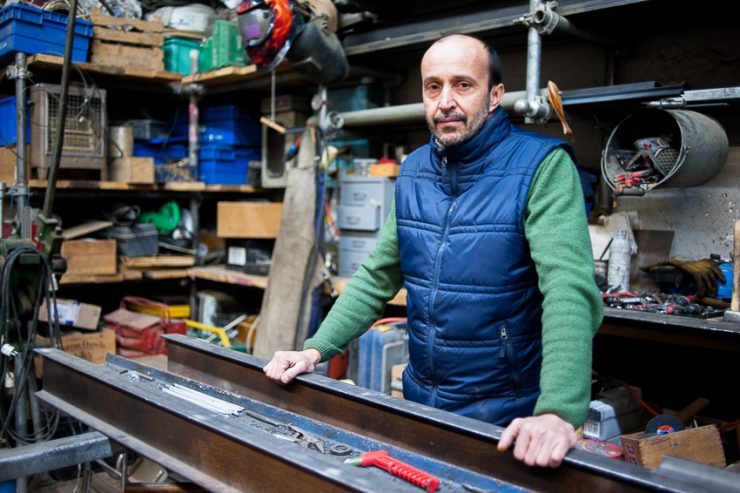
David Guillon’s ground floor workshop is a drafty relic of suburban Paris’ industrial past, with a high glass ceiling and a sandy floor. Planks of wood lean like groups of lanky teenagers along one wall and chunky blue-grey steel beams sit waiting to be cut against another. Here, Guillon designs and makes furniture by hand, which he sells under the name MadInPariss.
Besides the bookshelves, tables, and kitchen units you might expect, Guillon has also designed what is possibly the only existing mobile coffee unit in France. “We’re still not sure what to call it. We thought about the ‘Cafémobile’,” he says, laughing.
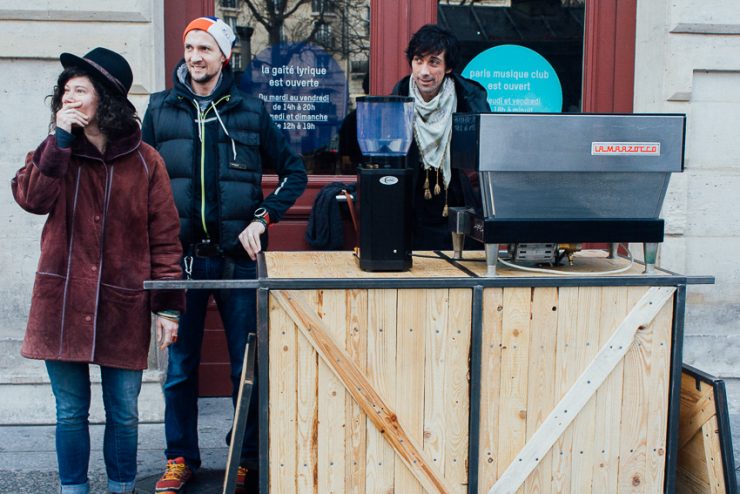
“We” includes Emmanuel Buschiazzo and Sandra Bouckenooghe, the baristas behind the counter of La Claque, a nomadic coffee stand that does pop-ups, private events, and workshops. While La Claque’s pop-up appearances could be chalked up to trend, Guillon points out that Buschiazzo and Bouckenooghe might be thought of as reviving the tradition of itinerant occupations that used to thrive in the streets of Paris. “Until the 1950s, Paris was full of small craftsmen: knife sharpeners, shoe shiners, and even people selling coffee or tea,” he says. “They’ve got a lot of guts to do that.”
Guillon himself is trying to carve out a living in a profession that has slowly disappeared from France, that of furniture making. “We still have the knowledge, but we don’t practice it, so we’re going to lose it,” he says of countries where industrialization has supplanted handcraft. Guillon does his best to source materials from Europe: his metal comes from Spain, and wood components from France, in the case of oak, or Poland, where he sources smooth, pale slabs pieced together from scraps destined for the wood stove.

After a difficult run trying to eke out a living in the job-scarce field of territorial development, Guillon enrolled in technical training for heating and plumbing, areas which he knew would always have work. “Plumbing is a good job. You bring people comfort in the form of hot water and heating,” he says. “I liked it, but there was something missing, and that was beauty.” So after ten years fixing pipes in Paris, Guillon went back to school to broaden his metalworking skills. Later, a collaboration with an Italian sculptor gave him the idea to focus on furniture design.
Guillon’s aesthetic is adamantly industrial: visible welds and deeply distressed grains are his signature. “I want people to see the materials for what they are,” he says. He refuses to paint his pieces and has a distaste for varnish, which he demonstrates for me with a piece of wood and a jug of water. “That’s what happens when you put varnish on wood,” he says, pointing to where the bone-pale surface had darkened to a tawny honey color. But Guillon understands that not everyone likes coffee rings on their living room table, so he hunted down a varnish that protects the wood without altering its natural appearance.
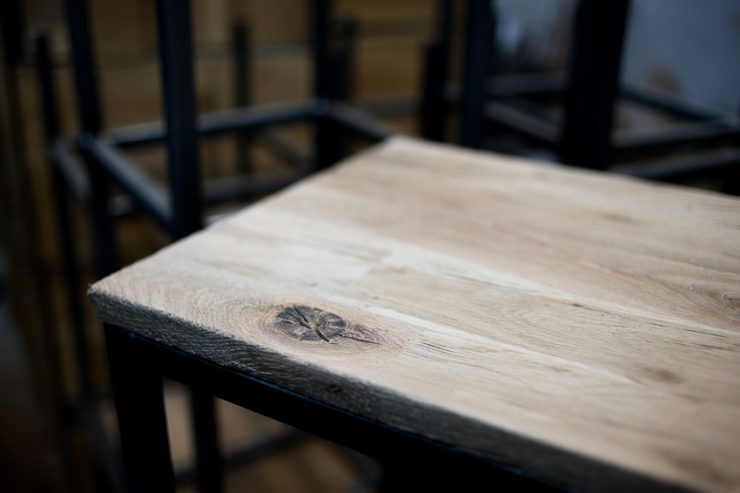
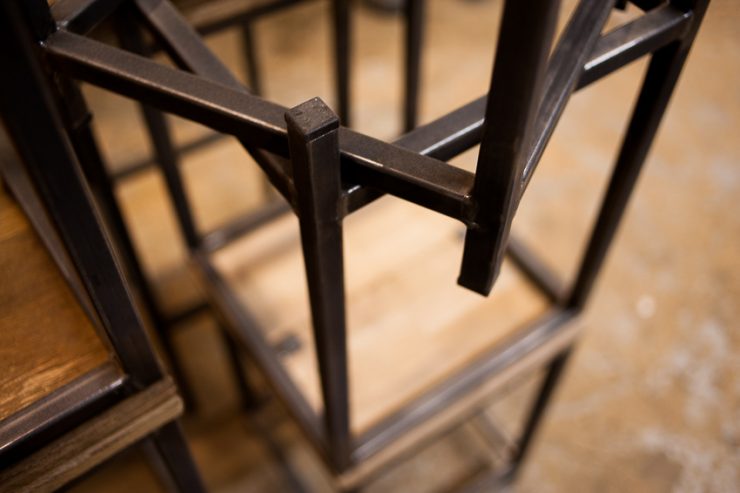
The metalworker’s dedication to simple forms and materials caught the attention of Chung-Leng Tran and his associates at the Hexagone Café who spotted his ad in the popular French online classifieds site Le Bon Coin. “We ended up talking for two hours, and in the end he offered to make the bar stools, counter, and bar,” says Tran. “There’s a lot of texture in his work. Depending on the day and the light, there’s a depth to the wood, and we really like that.”
When Buschiazzo came to Tran for advice on how to fix a gooseneck kettle that had broken during an event, Tran sent him to Guillon. “It all started with that kettle,” says Buschiazzo. Guillon re-welded the neck and the two got to talking about La Claque’s setup, which at the time was a homemade plywood counter that the baristas had thrown together themselves. Guillon helped them shore it up with a sturdy metal support, and then, over the next few months, the three worked on developing a longer-term solution in the form of a coffee cart.
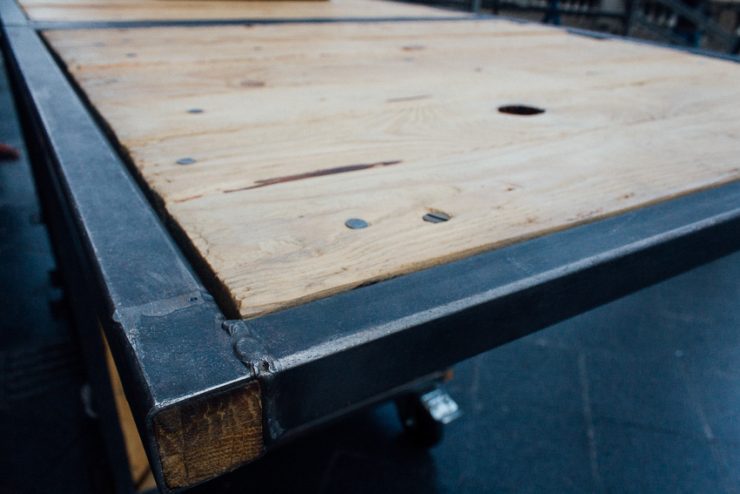
No one had created anything like it in France, so Guillon drew up his own design, loosely inspired by California-based Barista Capsule. To stay within La Claque’s modest budget, he used pallet wood. “When I started, I had the wooden crates of coffee that used to be hauled onto boats in mind,” he says.
Although these are his first projects for coffee professionals, Guillon is not entirely new to the business. “There was an industrial zone not far from the apartment complex I grew up in where La Maison de Café was located,” he says. “When we could smell the coffee in the center of town, we knew the rain was going to blow in.” But Guillon says working with Tran, Buschiazzo, and Bouckenooghe introduced him to a new kind of coffee. “I discovered something with them. Their coffee is different.”
Kate Robinson is a freelance journalist based in Paris. Read more Kate Robinson on Sprudge.
The post In Paris, Building Coffee Bars By Hand appeared first on Sprudge.

